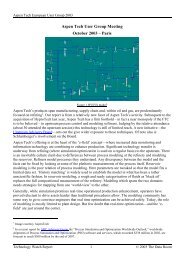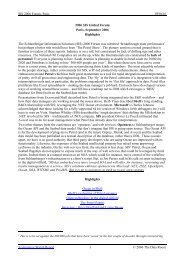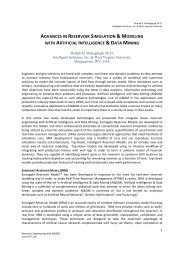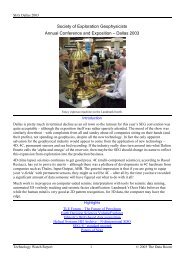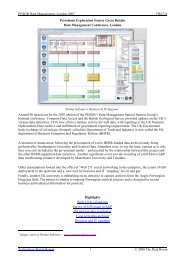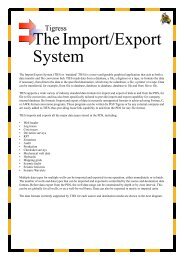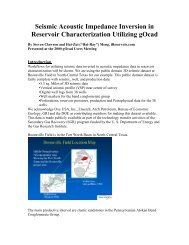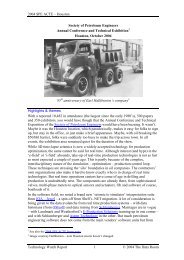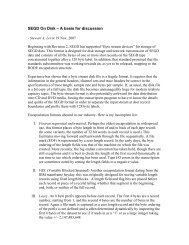EAGE London, 2007 - Oil Information Technology Journal
EAGE London, 2007 - Oil Information Technology Journal
EAGE London, 2007 - Oil Information Technology Journal
You also want an ePaper? Increase the reach of your titles
YUMPU automatically turns print PDFs into web optimized ePapers that Google loves.
<strong>EAGE</strong> <strong>2007</strong> - <strong>London</strong>, <strong>2007</strong>TW0708TW0708_10708_1.1Exhibitors - SoftwareComputer Modelling Group – modeling Sleipner CO2 sequestrationCO2 sequestration simulation in CMG’s GEM.CMG’s reservoir flow modeling extends to CO2 sequestration as shown in the above image from the world’s firstindustrial scale sequestration project on the Sleipner area, Norwegian North Sea. Sleipner produces a millionmetric tons of CO2 per year which is stored in the Utsira acquifer in the EU-funded CO2STORE project(www.co2store.org). The graphic shows CMG’s model of the the long-term fate of CO2, with concentrations(yellow and pink areas) of CO2 dissolved in the salt water and where the CO2 has been converted into calcite overa period of about 500 years. Calcite conversion assures permanent CO2 sequestration. More fromdan.dexter@cmgl.ca and www.cmgl.ca. See also the EU Network of Excellence on C02 Geological Storage –www.co2geonet.com and info@co2geonet.com.0708_1.2Earth Works – MPSI 1 Stochastic Inversion deal with Arc CLSEarthworks’ UltraFast MPSI Stochastic Inversion <strong>Technology</strong>1 Multiple prediction using sparse inversion.<strong>Technology</strong> Watch Report 3 © <strong>2007</strong> The Data Room
<strong>EAGE</strong> <strong>2007</strong> - <strong>London</strong>, <strong>2007</strong>Earthworks has signed with ARK CLS for commercial development of its ‘UltraFast MPSI Stochastic Inversion<strong>Technology</strong>. The first release will include 3D geostatistical model building, error grid constraints and post-stackdeterministic and stochastic inversion. More from http://www.sorviodvnvm.co.uk.TW07080708_1.3Geocap/Roxicon – interpretation package and Norwegian ‘super seismic survey’Roxicon Super Seismic Survey in Geocap viewer.First announced in 2000, Geocap was founded by Olav Egelend formerly with Technoguide/IRAP. Geocap’stechnology is used by the UN in geological and bathymetric visualization for OCS mapping and law of the seaarbitration. The product is now available for use in oil and gas as a flexible data visualization environment. Userscan interact with data via a scripting shell, ‘make grid’, ‘map’ etc. and build workflows from commands. Geocapuses an Open Data Model from www.kitware.com. 3D visualization is available through a partnership with CyViz– www.cyviz.com. More from www.geocap.no.Part of Roxicon’s Norwegian Super Seismic Survey.<strong>Technology</strong> Watch Report 4 © <strong>2007</strong> The Data Room
<strong>EAGE</strong> <strong>2007</strong> - <strong>London</strong>, <strong>2007</strong>Geocap is used to visualize Roxicon’s Super Seismic Survey (above) a non exclusive compilation of Norwegianseismic data in the style of PGS’ MegaSurveys. The SSS is delivered with velocity data. More fromwww.roxicon.no.TW07080708_1.4 IFP Archeo-Modeling – semantic web services for geo model managementThe strangely-named ‘Archeo-Modeling’ joint industry proposal by the French Petroleum Institute (IFP) is todevelop a semantic web services-based methodology for capturing geological model data from legacy modelformats such as RESCUE and GRDECL. The project will leverage work presented in the paper ‘KnowledgeManagement for Shared Earth Modeling’ below. More from Jean-Francois Rainaud – j-francois.rainaud@ifp.comand http://www.ifp.fr/IFP/en/files/rechercheindustrie/JIPs-2006/Archeo-Modeling.pdf.0708_1.5 IKON Science – modeling while pickingIkon has grown to 70 employees on the strength of its RokDoc modeling while picking package. RokDoc 5.2includes a Petrel link (funded by Shell and BG). The Petrel add-on, marked by Ikon, displays two windows.RockDoc’s Java application receives broadcasts from Petrel’s .NET development. Ikon is also consolidating itsrecent Geopressure <strong>Technology</strong> acquisition adding pressure modeling to RokDoc. More fromwww.ikonscience.com and a downloadable movie of modeling while picking is available athttp://www.ikonscience.com/RokDoc5.2%20demo.wmv.0708_1.6JOA Jewel Suite – now integrated with ECLIPSEJOA Jewel Suite now offers Eclipse connectivity.JOA’s Jewel reservoir-focused interpretation and modeling package now offers connectivity to Schlumberger’sECLIPSE reservoir fluid flow simulator. Jewel also now offers uncertainty management and a new Windows XP64 bit release of the package.<strong>Technology</strong> Watch Report 5 © <strong>2007</strong> The Data Room
<strong>EAGE</strong> <strong>2007</strong> - <strong>London</strong>, <strong>2007</strong>TW0708Quick project screening in JOA Jewel Suite.According to JOA, majors and mid market oils use Jewel Suite, particularly for its flexible gridding of complextectonics. The demo we saw involved the screening of a Gulf of Guinea prospect. Horizons and faults wereimported into Jewel which was then used to clean up the terminations before the automated triangulated meshprocess. This handles complex faults and stacked reservoirs. Reservoirs and other objects are defined in thehierarchy builder. Gridding is highly orthogonal but ‘unstructured’ and provides ‘a good representation of faults.’More from Gerard de Jager dejager@joa.nl and www.joa.nl.0708_1.7Justcroft – JustCGM and JustMontageJustcroft’s JustMontage 2.2.CGM specialist Justcroft has announced a new version of its computer graphics metafile (CGM) montage packageJustMontage 2.2. Other Justcroft tools include JustCGM and JustPlot. More from Patrick Squirespsquires@justcroft.com and www.justcroft.com.0708_1.8 Kadme/Digital Earth – new data service announcedUK-based startup Digital Earth is to use Kadme’s search and mapping technology to power its global energyindustry information portal. In return, Kadme will have access to Digital Earth’s (DE) ‘social search’ andunstructured data solutions for its own clients. DE’s game plan is to develop ‘next generation’ search andcollaboration tools for the energy industry. DE sources its information with a network of regional scouts, theinternet, telephone calls, email enquiries, personal visits and trade shows. More from www.digital-earth.com andwww.kadme.com.<strong>Technology</strong> Watch Report 6 © <strong>2007</strong> The Data Room
<strong>EAGE</strong> <strong>2007</strong> - <strong>London</strong>, <strong>2007</strong>0708_1.9Kongsberg-Intellifield – Discovery Portal, Wells and Vispo3DTW0708Discovery Portal - drilling activity monitoringKongsberg’s Discovery Portal allows map-based surveillance and drill down of geographically dispersed drillingoperations.Discovery Wells – Real Time WITSML multi-vendor data feedsDiscovery Wells displays WITSML drilling data in real-time including time and depth-indexed data, real-time andhistorical data, and a mixture of data from multiple-vendors and rigs in a configurable graphical user interface.<strong>Technology</strong> Watch Report 7 © <strong>2007</strong> The Data Room
<strong>EAGE</strong> <strong>2007</strong> - <strong>London</strong>, <strong>2007</strong>TW0708Reservoir management in Vispo3DKonsberg’s Vispo3D Reservoir Management targets life of field production optimization by creating a 3Dcollaborative workspace for cross-functional teams, bringing together ‘people, processes and technology in asingle web-based application.’ More from ingunn.kolltveit@intellifield.no and www.intellifield.no.0708_1.10 Landmark - new OpenWorks data model, OpenSpirit connection and ProMax pre stackLandmark is counting down to the OpenWorks R5000 release which includes a new data model. This will bringnew efficiencies for data managers and in particular, heralds enhancements to the treatment of coordinate referencesystems—which has been an ‘area of frustration’ for users. The new OW data model introduces multi projectmanagement, security and the ability to subset data for distribution to partners. Landmark acknowledges that thiswill be a major disruption and that customers will need (and get) help with migration.Landmark has also come fully into the OpenSpirit fold in order to extend its DecisionSpace infrastructure and devkit to third party data store access. Customers can now access 13 multi-vendor data stores from DecisionSpaceapplications.New functionality in Promax/SeisSpace includes new data structures and point and click access to gathers from aCDP fold map. Simplified depth imaging workflows now offer easier parameter selection and management ofcluster resources. More from www.lgc.com.0708_1.11 Midland Valley Exploration – Real Time Model UpdateReal Time Model Update tool for 3DMove.Midland Valley has added a Real Time Model Update tool to its 3DMove package. The above image shows a 3Dmodel updated according to a revised horizon pick at the well. The amount of reshaping is indicated by the colourmap. The lateral extent of reshaping can be adjusted. The layers underneath the modified horizon are reshapedpassively so that the model retains its geological coherence. After the modification, the well can be projectedahead in the new model and the prognosis revised. More from www.mve.com.<strong>Technology</strong> Watch Report 8 © <strong>2007</strong> The Data Room
<strong>EAGE</strong> <strong>2007</strong> - <strong>London</strong>, <strong>2007</strong>0708_1.12 NORSAR – SeisRox seismic response modeling for survey designTW0708NORSAR’s simulated prestack local imaging (SimPLI) workflowNORSAR’s SeisRox seismic modeling interface.NORSAR’s SeisRox models the seismic response of hydrocarbon reservoirs for survey design, interpretation and4D time lapse data analysis. SeisRox simulates 3D pre stack depth migration to investigate overburden effects onimagery. SeisRox uses ‘full rock physics – based modeling’. The SimPLI workflow takes SeisRox model outputand simulates PSDM imagery. Trial and error property changes can be made with immediate feedback of results.More from www.norsar.com.<strong>Technology</strong> Watch Report 9 © <strong>2007</strong> The Data Room
<strong>EAGE</strong> <strong>2007</strong> - <strong>London</strong>, <strong>2007</strong>0708_1.13 Open Spirit – web serverTW0708OpenSpirit Web ServerOpenSpirit has seen strong growth since Paradigm took a share in the company. The new Web Server above offersbrowser-based access to OpenSpirit-enabled data stores and GIS data. The web server leverages a TomcatApplication Server to generate ‘servlets’ like ‘sendDataSelection’, ‘sendGISFeature’, ‘kmlfromSDE’. Along withthe browser version there are ArcGISExplorer and Google Earth clients. Open Spirit is now looking to cover otherworkflow domains. More from www.openspirit.com.0708_1.14 Paradigm – High Performance Volume Interpretation (with Scalable Graphics)Gocad 2.5 HPVI running on Scaleable Graphics hardware<strong>Technology</strong> Watch Report 10 © <strong>2007</strong> The Data Room
<strong>EAGE</strong> <strong>2007</strong> - <strong>London</strong>, <strong>2007</strong>TW0708Geomodeling’s VisualVoxAT now sold by RoxarFinally, Roxar has signed a worldwide agreement deal with Geomodeling for the resale of its seismic interpretationsoftware, VisualVoxAt. More from www.roxar.com and www.geomodeling.com.0708_1.17 Schlumberger (with Statoil) – Results ManagementStatoil’s Cathrine Gunnesdal described the use of Schlumberger’s ProSource Results Manager (RM) for capturinginterpretation results from key applications including SeisWorks, OpenWorks (OW), ZMap, EMS and Eclipse.Statoil has corporate and project data managers. Statoil uses RM to capture projects at ‘decision gates’ such as arecommendation to drill, following a basin modeling exercise or prior to a license application. A high level Statoilgovernance ruling obligates knowledge workers to clean up their projects before storage in RM. According toGunnesdal, standard nomenclature has been the key to success. Project data is kept for a year before deletion.ProSource is also used to create and QC OpenWorks projects and particularly, to track which seismicinterpretation goes with which eclipse model—this is ‘impossible in normal workflow.’ The benefits to Statoilinclude an ‘awareness of doing things right,’ assuring data management and quality through a proactive approachand a strict nomenclature. The system has successfully re-created an accidentally deleted model that was in dailyuse. This was fully restored to OW in 10 minutes. Because project re-build is so easy, Statoil now recommendsonly use of ‘daily’ data in OW. Partner data creation is also facilitated – it took 20 minutes to export an ASCII fileof a project model. Statoil has 17 people in central data management support, more in the assets. More fromhttp://www.slb.com/media/services/software/im/prosourcerm_prodsheet.pdf.<strong>Technology</strong> Watch Report 12 © <strong>2007</strong> The Data Room
<strong>EAGE</strong> <strong>2007</strong> - <strong>London</strong>, <strong>2007</strong>0708_1.18 TGS-Nopec/A2D Facies Map BrowserTW0708Aceca Facies Map Browser correlation using a vertical scale in millions of years.The Aceca Facies Map Browser (FMB – now part of TGS Geological Products & Services) provides visualizationof depositional systems models derived from an interpreted well database tied to reference 3D seismic volumes.FMB displays details of the basin stratigraphy and fill, with an audit trail providing context and background to theinterpretation results. Depositional systems maps are derived from UK, Irish and Norwegian released seismic andwell data. More from Jenny Salinas Jenny.Salinas@tgsnopec.com and http://www.aceca.co.uk/.0708_1.19 Zeh/Horizon GIMSHorizon’s geological information management system GIMS.Zeh is expanding its software lineup with Horizon’s ‘GIMS’ geological data management package. GIMS is a datamanagement tool for management of physical and digital assets. GIMS offers a GIS interface, viewers for PDF,TIF, LAS, SEG-Y and assures information traceability and a secure master data archive. GIMS originated as afront end to Fugro-Roberston’s SE Asia geology, geochemistry and biostratigraphy dataset. The data viewer andservice combo displays well spots with drill down to a pdf of say, a palynology report. ‘Worksets’, collections oflinks to data, are used to create farmout CD distributions. Zeh is working to integrate GIMS with its SeisInfo<strong>Technology</strong> Watch Report 13 © <strong>2007</strong> The Data Room
<strong>EAGE</strong> <strong>2007</strong> - <strong>London</strong>, <strong>2007</strong>package. ZEH was also showing its CGM plug-in for Petrel <strong>2007</strong>.1 – used to export Petrel graphics to CGMmontages. More from www.zeh.com and Andy Livsey arl@horizon.co.id.TW0708TW0708_2 Exhibitors – Hardware and StorageA good introduction to some of the issues behind storage area networks (SAN), network attached storage (NAS)and virtualization is available on http://en.wikipedia.org/wiki/Storage_area_network. In the recent past, pre stackdata was confined to the ‘silo’ of the processing house. Seismic processors would take the vast data volumesrecorded in the field (some 300 terabytes (TB) for a Gulf of Mexico 3D survey) and process it down to a fewhundreds of GB for interpretation. But interpreters interested in amplitude vs. offset, or other pre-stack indicatorsof the presence of hydrocarbons are increasingly leveraging pre-stack data—stressing data storage, networkbandwidth and project data loading times. According to a NetAPP estimate, there are about 70 petabytes (PB) ofupstream data stored on spinning disks today.0708_2.1 Blackberry in <strong>Oil</strong> and GasBlackberry has appointed an oil and gas contact, Thomas Neubauer (tneubauer@rim.com) and was showing someapplications developed by partner companies. BFI is extending Siemens’ Siematic process control infrastructure toBlackberry users. More from Christian Schad cs@bfinet.de and www.bfinet.de (although mostly in German).Another Blackberry associate IQlink offers Blackberry integration with SAP – contact Peter Stapellspeter.stapells@iqlink.co.uk.0708_2.2 EMC Centera ‘soup to nuts’ provider.EMC2 offers solutions for high performance computing and clustered file systems and is working with Landmarkon a hardware/software bundle of the OpenWorks R5000 synchronous release. In its recent acquisition spreeEMC2 has acquired Documentum, the Smarts network manager, VMWare’s server virtualization and Rainfinity’sfile virtualization. Rainfinity’s digital rights management technology encrypts data at the file level and is claimedto offer synergy with Landmark and Schlumberger’s applications. EMC2 is also offering best practices formigration and upgrade to Oracle 10G. EMC file systems equip HPC clusters deployed by Exxon, WesternGecoand Statoil – all used for seismic processing. The global file system and SAN is exposed to the cluster as NAS. AGartner study described EMC2 as a ‘soup to nuts’ provider. More from Peter Hodge Hodge_peter@emc.com andwww.emc.com.0708_2.3 Headwave - ‘Headwave for Interpreters’Headwave is now selling its pre-stack data access technology independently of Petrel as a stand alone pre-stack‘Headwave for Interpreters’ (HfI) package. The GPGPU compression-based technology offers access to terabytesize data sets without requirement for a storage cluster. Compression/decompression is performed on $500NVIDIA 8800 cards. The system targets pre-stack interpretation or processing. Compression technology is used onFugro’s seismic boats and in an ‘undisclosed’ interpretation system. A 64 bit release is scheduled for later thisyear. Floating point math will also be available real soon with a new CUDA release. Plans are now to add pickingfunctionality to the HfI package and to extend the GPGPU-based number crunching to seismic processing. Morefrom www.headwave.com.0708_2.4 IBM – Deep Computing Visualization, Simudyne, Blue GeneDeep Computing Visualization (DCV) offloads graphics to dedicated hardware and now supports a Windows XPclient so that Petrel users can benefit. Part of IBM’s DCV effort involves developing a ‘convergent’ visualcomputing paradigm so that, for instance, ‘Petrel and Geoprobe could cooperate at a meta layer via openvisualization standards.’<strong>Technology</strong> Watch Report 14 © <strong>2007</strong> The Data Room
<strong>EAGE</strong> <strong>2007</strong> - <strong>London</strong>, <strong>2007</strong>TW0708Simudyne’s AutoCore pattern recognition application classifies prestack seismic data.IBM partner Simudyne was showing a rather obscure technology leveraging the Cell Broadband Engine (BE) asused in the new Sony Playstation. Simudyne’s ‘AutoCore’ is described as a virtual machine that uses an‘evolutionary computing’ technique for seismic analysis and pattern recognition. Other applications address steamand water injection program optimization. The system is said to ‘write its own software’. Chevron and Statoil aresaid to be trialing the box. More from Justin Lyon - justin@simudyne.com and www.simudyne.com.IBM claims 15 teraflops from its Blue Gene ‘petascale’ machine.IBM is also active in high performance computing with its Top500-winning Blue Gene. By building high-endinterconnect into the hardware IBM claims very high real bandwidth—280 out of theoretical 360 TF machine.Commodity-based clusters usually max out at around 10% of their notional peak. More from Earl Dodd -earldodd@us.ibm.com and http://www-03.ibm.com/industries/chemicalspetroleum/index.jsp.0708_2.5 Isilon IQ storageSeismic Exchange has a petabyte of seismic data hosted on Isilon IQ clustered storage. The central repository of itsproprietary 3D seismic library is powered by Isilon’s OneFS operating system software. This unifies 30,000 totalsquare miles of 3D seismic imaging data into one ‘seamlessly expandable’ pool of high-performance storage.<strong>Technology</strong> Watch Report 15 © <strong>2007</strong> The Data Room
<strong>EAGE</strong> <strong>2007</strong> - <strong>London</strong>, <strong>2007</strong>Integration was performed by Network Touch and the Houston <strong>Information</strong> Team. More from Gary Willoughbygary.willoughby@isilon.com and www.isilon.com.TW07080708_2.6 Net App – Chodi and Gavin KeelerNetApp is evolving its offering from hardware to include application support. Many upstream applications runacross Oracle and flat files which NetApp consolidates to a single system, simplifying backup procedures. NetAppclients include Shell (4 PB), Aramco (2½ PB) and Petrobras (5 PB). NetApp has several certification programsongoing with Landmark and Schlumberger. NetApp systems are also resold by IBM as the N-Series. See alsoNetApp’s white paper ‘Effective Practices for <strong>Information</strong> and Data Management in the Upstream <strong>Oil</strong> and GasIndustry.’ NetApp does not think the E&P data explosion is going to end any time soon. Today the company islooking at keeping more prestack data online to support huge processing requirement and to manage multiplyingseismic data volulmes across processing and storage. More from Chodi McReynolds chodi@Netapp.com andwww.netapp.com/oilandgas.0708_2.7 Sun – reforming oil and gas unitSun has reformed its recently disbanded oil and gas unit and is getting back market share with its x86 workstationsand the ‘Thumper’ 24 TB storage system. Dual AMD processor workstations are used by Devon, BP, Conoco-Phillips, Chevron and WesternGeco. Sun’s top-flight U40 workstation with dual NVIDIA 5600 cards is in theprocess of certification with Landmark. Sun’s acquisition of SeeBeyond has given it an SOA offering. SeeBeyondis used by BP for global identity management. Finally Sun’s ‘Project Blackbox’ delivers a configurable datacenter, high performance computer or whatever you need in a standard shipping container. More fromhttp://www.sun.com/products/soa/index.jsp andhttp://www.sun.com/solutions/landing/industry/energy/oil_gas.xml.0708_2.8 Tyan Computer – Personal SupercomputerTyan’s new PSC T-600 series Personal Supercomputer is a 5-node cluster with Intel 50-watt quad-core processorsand up to 60TB RAM.The Tyan PSC T-600 series is delivered as a ready to use pre-tested cluster configuration.ISV partnerships include ANSYS/Fluent, LSTC, Wolfram Research. Prices from $20,000. More from HowardWiblin howardw@tyan.eu and www.tyan.com.0708_2.9 Verari – VB 5150 Storage SystemVerari’s VB 5150 Storage Subsystem for the BladeRack 2 holds up to 576 TB of NAS storage per rack. Verariclaims over 1 petabyte of storage sold to the oil and gas vertical. Drive choices include 500GB, 750GB or 1TBSATA II hard drives. RAID levels supported include RAID 6 and 60. Utilizing RAID 6, a VB5150 StorageSubsystem can tolerate two simultaneous disk failures, drastically reducing the risk of unrecoverable media errorsduring rebuilds. More from www.verari.com/storage.asp.TW0708_3Exhibitors - other0708_3.1 Cydarex (IFP Group) poroperm from cuttings and core analysisCydarex’ hardware performs porosity and permeability from drill cuttings. Only a few cubic centimeters arerequired for the analysis. More from contact@cydarex.fr and www.cydarex.fr (although a rather uninformativehome page).0708_3.2 Ovation/DPTS – Data Stewardship ProgramOvation’s Data Stewardship program, which hosts and refreshes companies’ E&P data has met with modestsuccess with five US clients signed-up and management of CGG’s 120TB multi-client library. More fromwww.ovationdata.com and www.dpts.co.uk.<strong>Technology</strong> Watch Report 16 © <strong>2007</strong> The Data Room
<strong>EAGE</strong> <strong>2007</strong> - <strong>London</strong>, <strong>2007</strong>0708_3.3Pinnacle Technologies – GPS InSAR deformation analysisTW0708Satellite-based radar surveys reveal subsidence caused by oil production.Pinnacle offers a combination of downhole microseismics surveillance and satellite-based deformationmeasurements to track ground movement such as compaction during oil and gas production. GPS InSARmeasurement has been used to follow Shell’s ‘Huff n’ Puff’ heavy oil production in Canada’s Peace River field.Pinnacle sees the technique as an alternative to 4D seismics. Deformation measurements can be made daily. Thetechnique can also be applied to CO2 sequestration. More from www.pinntech.com.0708_3.4TRE – Marco BianchiPSInSAR time-lapse study over compacting oil field.TRE is a spin-out of the Italian R&D Polmi establishment. The PSInSAR technique involves satellite-based radar‘permanent scatter interferometry’ to measure ground displacement (compaction) down to 1mm/year. A cornercube reflector can be deployed for increased precision. A map of <strong>London</strong> shows subsidence along the new Jubileetube line (in conformity with engineering prognosis). PSInSAR data is integrated into a GIS environment togenerate deformation maps and contour lines of the displacement field. More from Laura Pezzottilaura.pezzotti@treuropa.com and www.treuropa.com.TW0708_4 Papers of noteAs usual, information and data management papers and poster sessions were lumped in with ‘other seismicprocessing’ or ‘near surface effects in E&P’. The reviewing process has let through some interesting vocabulary –‘interessement,’ ‘problematization’ and especially ‘oralnology’ and ‘oralnic.’ The last two are intriguing in thatthe authors did not bother to say what these ‘neologisms’ actually mean despite the fact that they are not in thedictionary and are virtual ‘googlewhacks.’<strong>Technology</strong> Watch Report 17 © <strong>2007</strong> The Data Room
<strong>EAGE</strong> <strong>2007</strong> - <strong>London</strong>, <strong>2007</strong>TW07080708_4.1 Automated Geobody Extraction with 3D Waveform Sequences 1 – H. Borgos (Schlumberger) et al.Classification techniques used to automate 3D seismic sequence interpretation and geobody extraction – very nicegeobody images in Petrobras data.0708_4.2 Solving the data management puzzle 2 – F. Hunault, (Total)The paper summarizes the gap between perception of perfect data management and the reality of ‘incompatibledata models, poor interfaces, missing components and incompatible software.’ Total has attempted to solve thepuzzle with a single large virtual database, the ‘Intranet Geosciences Data Base’ (IGDB). The IGDB leverages aUnique Identifier (ID) for E&P objects, the use of Oracle ‘materialized views’ instead of data copy and intelligentreplication. The work in progress still relies in part on ASCII data exchange to circumvent proprietary datasources. Paper includes an interesting critique of vendors’ ‘non-imbricated’ solutions. But salvation lies in ‘webservices, GIS integration and the common data model.’0708_4.3 Seismic processing tests on the CELL 3 – C. Bednar, Panorama TechnologiesPaper describes progress in porting seismic code to the IBM Cell BE (the chip used in the Sony Playstation III).Panorama’s software installed without difficulty on the CELL architecture. Tests so far show finite differencecodes execute ‘on the order of’ 9.94 times faster than on a 2.2GHz AMD processor. Ray tracing performanceremains problematical.0708_4.4 Multidisciplinary real time monitoring 4 – E. Tan, Halliburton et al.Real time technology as applied to Petronas’ Angsi development from rig site data collection, transmission andweb-based delivery. Real time data is integrated into a geological and geophysical project database and 3Dvisualization tool for viewing of planned and current well trajectories in the context of a ‘Drill to Earth Model’approach incorporating existing wells and operational data. The project was built around Baker Hughes INSITEreal-time data management system. Third party rigsite data integrated with WITS. Access to web-based dataleverages Novell i-Chain 5 single sign-on. Paper includes an exhaustive list of applications used on the project.0708_4.5 Knowledge Management for Shared Earth Modeling 6 – L. Mastella et al., Paris School of MinesShared Earth Modeling (SEM) should allow sharing of data and knowledge related to data interpretation .Aprototype ontology-based ‘Geological Knowledge Editor’ (GKE) has been developed to support SEM knowledgemanagement and assure reservoir modeling ‘quality of service.’ The GKE displays fault networks and stratigraphiccolumns and supports model editing and automation. The GKE leverages semantic web technologies to developand deploy SEM related ontologies (shared vocabularies). The project is to develop a meta model to describe datain existing formats such as RESCUE, GRDECL or GoCad.0708_4.6 Permanent Fiber-Optic Borehole Seismic at Valhall 7 – B. Hornby et al., BPThe world’s first successful installation of a permanent borehole seismic system in an offshore production well.The fiber-optic based system has 5 levels of 3component seismic sensors. Active seismic data has imaged out to400m from the borehole. Passive (micro-seismic) monitoring is used to track chalk compaction as the reservoir isproduced and to monitor cuttings injection and well stimulation.0708_4.7 Concept Uncertainty in Seismic Interpretation 8 – C. Bond et al., Midland Valley ExplorationA synthetic seismic section was built over a known structural feature and shown blind to some 400 interpreters.The results showed ‘success rates’ of less than 21% in identifying the tectonic setting and below 2% success atidentifying 90% of the key features. The low success rates illustrate the risks of deriving a single deterministicmodel for a massively under constrained interpretational problem. Modern workflows that attach uncertainty toindividual parameters such as permeability mask major uncertainties in the geological model.1 http://www.earthdoc.org/detail.php?paperid=B014&edition=27.2 http://www.earthdoc.org/detail.php?paperid=H008&edition=273 http://www.earthdoc.org/detail.php?paperid=E041&edition=27.4 http://www.earthdoc.org/detail.php?paperid=D013&edition=27.5 http://www.novell.com/products/ichain/.6 http://www.earthdoc.org/detail.php?paperid=D021&edition=27.7 http://www.earthdoc.org/detail.php?paperid=P201&edition=27.8 http://www.earthdoc.org/detail.php?paperid=P242&edition=27.<strong>Technology</strong> Watch Report 18 © <strong>2007</strong> The Data Room
<strong>EAGE</strong> <strong>2007</strong> - <strong>London</strong>, <strong>2007</strong>TW07080708_4.8 Real-time quality control of directional survey data 1 – R. Nyberg et al., StatoilReal time QC of deviation showed that gross errors and/or poor tool performance affected some 94% of Statoil’soperated wells over a three year test period. The in-house developed Survey QA/QC application connects toservice companies’ WITSML servers and streams standard parameters and survey data into Statoil’s DirectionalDrilling Database.0708_4.9 A geophysical metadata hierarchy 2 – L. Sores, Eotvos Lorand Geophysical InstituteThe European GEOMIND project is to create a web map services-based GIS portal for geophysical metadata anddata services. This paper describes an XML geophysical community profile for the ISO19115 Metadata model anda generalized geophysical data model. The profile includes digital rights management, data quality, EPSGcoordinate system codes, source datasets and descriptive keywords for thematic search. ISO19115 is based onXML schema definitions included in the ISO19137 standard. The multilingual geophysical metadata and dataportal will leverage a new XML schema-based language to describe geophysical datasets.0708_4.10 Experimental design for uncertainty analysis and optimization 3 – H. Kloosterman et al.A range of subsurface uncertainties and development options analyzed using Experimental Design (ED). 40 keydevelopment option parameters were then optimized. Design and analysis of simulation runs were performedusing commercially available software from JMP (http://www.jmp.com/applications/doe/index.shtml).0708_4.11 C034 Exploration Potential of the Middle East – A. Fraser et al., BPComposite Common Risk Segment mapping of the future potential of the Middle East shows over 100 billion boeto be found with some in likely ‘super giant’ fields of over 1 billion boe. The bulk of the remaining undiscoveredoil potential is likely to lie in the Tertiary and Mesozoic trends of the northern Gulf (Kuwait, Iraq, Iran).TW0708_5 SEG D Rev 3 updateThe SEG standards committee met at the <strong>EAGE</strong> to progress the SEG-D Rev 3 tape standard. This is lookingbeyond conventional seismics to new data types including passive ‘interferometry’ and seabed EM. The committeeis planning a web service for software conformity testing. SEG-D has not embraced XML, but with more rigorouslock down of bit positions it should be easier to translate header information to a tagged format.TW0708_6<strong>Technology</strong> Watch Subscription <strong>Information</strong>© July <strong>2007</strong>The Data Room7 rue des VerrieresF-92310 Sevres FranceTel (USA) 281 968 0752Tel (UK) 020 7193 1489Tel (France) +33 1 4623 9596Fax +33 1 4623 0652info@oilit.com1 http://www.earthdoc.org/detail.php?paperid=P153&edition=27.2 http://www.earthdoc.org/detail.php?paperid=P152&edition=27.3 http://www.earthdoc.org/detail.php?paperid=H035&edition=27.<strong>Technology</strong> Watch Report 19 © <strong>2007</strong> The Data Room




